


Ladies and Gentlemen,
On a quiet summer evening in august 1917 , in the middle of the First World
war, a small German Seaplane had to make an emergency landing in Dutch
territorial waters in the north of Holland. During the First World War, Holland
had assumed a neutral position. As a consequence they were obliged to imprison
soldiers from both sides. So obviously they set about to rescue and capture the
German pilot and to salvage his plane. In his plane they discovered something that
surprised them: a radio receiver

Now, radio was still something of a novelty in 1917. In 1887 Heinrich Hertz
had demonstrated the existence of electromagnetic waves by inducing extremely
small sparks in a resonant antenna. When asked about the practical importance of
his experiments he replied: “It's of no use whatsoever, this is just an experiment that
proves Maestro Maxwell was right." Asked about the ramifications of his inventions
Hertz replied: "Nothing, I guess."

Well, that was not what 8 years later the
Italian inventor Marconi had in mind. Marconi may well be called the Bill
Gates of radio. Both man have a lot in common: they are both largely autodidact
not finishing their educations, both man had a clear vision and an enormous drive
to turn their vision into a commercial success, and finally, both man largely built
their products on ideas from others. Marconi, inspired by the experiments of
Hertz, had the vision of commercial wireless telegraphy. After furious
experimenting and building on the work of Alexander Popov and Edouard Branly,
Marconi built a “wireless telegraph” that could bridge a distance of 2.5 km.
Finding little interest in his work in Italy, Marconi immigrated to England at the
age of 22, to further pursue his dream. He gave several successful
demonstrations for British postal and military officials, during which he gradually
increased the transmitting distance of his system.

Finally, in 1903 he
succeeded in transmitting a message over the Altlantic Ocean between Poldhu in
Cornwall and Signal Hill near St. John in Newfoundland, a distance of more than
3000 kilometers.
The Marconi system used damped electromagnetic oscillations generated by
sparks. This worked reasonably well for telegraphy, but it generated an awful
amount of noise and was therfore completely unsuitable for speech. For speech
transmission a continuous wave was needed, but the problem was that around
1900 nobody had the faintest idea how a continuous wave at reasonably high
frequencies could be generated.

The first usable semi-continuous wave
oscillation was generated with the synchronous rotary-spark-gap transmitter
designed by the visionary American Reginald Fessenden. Fessenden, who by the
way also didn’t finish his high school education, learned his skills in Edison’s
Laboratory.

Using his Continuous wave transmitter, Fessenden broadcasted
on Christmas Eve in 1906 the world’s first radio program in which he made a
speech an played the Largo from Handel on his violin. It was a milestone in the
history of radio, but unfortunately remained an little known incident. For the next
fifteen years radio and wireless telegraphy would be limited to military and
maritime applications.
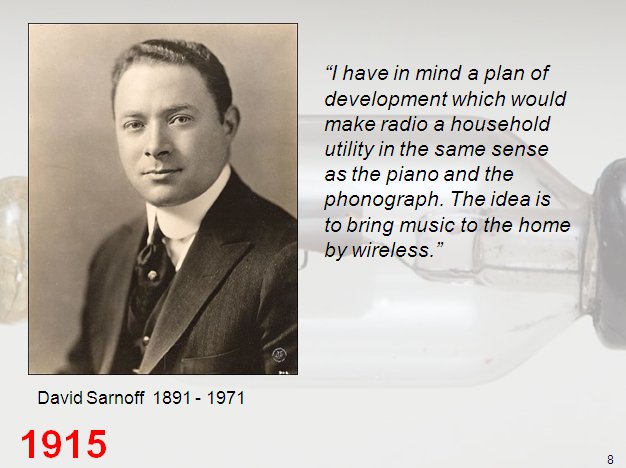
In 1915 a young employee of the American Marconi
company and future founder of NBC, David Sarnoff, wrote a remarkable
memorandum to the board of directors: “I have in mind a plan of development
which would make radio a household utility in the same sense as the piano and
the phonograph. The idea is to bring music to the home by wireless.” The
memorandum was rejected, because radio was considered to be an instrument
for point-to-point communication. The idea of broadcasting information to a large
audience was simply something unheard of.

This pretty much summarizes the status of radio at the time when the military
discovered the radio receiver in the German airplane. As it turned out, it was quite
an advanced radio because it used two EVN 94 vacuum tubes from Telefunken,
switched in cascade!
As you know, all radio receivers need some kind of a device to detect the
presence of the radio waves.
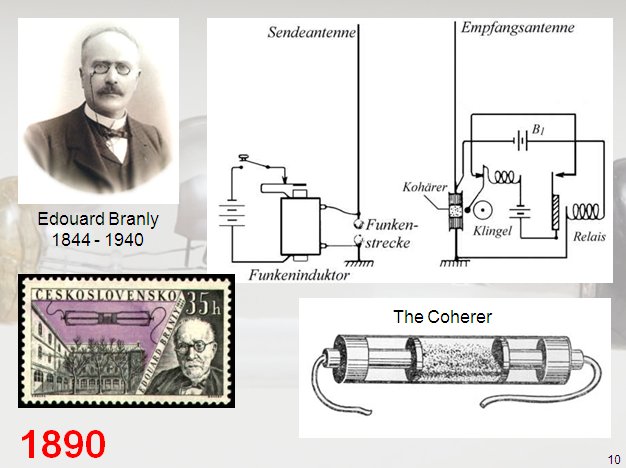
Marconi used in his wireless telegraphy
instruments a so called coherer which was invented by Branly in 1890. A coherer
is a device consisting of a glass tube filled with some metal filings usually nickel in
between two platinum electrodes. In the normal off state, the DC resistance
between the electrodes is very high. However, when an RF signal from an
antenna is passed through the electrodes, the metal particles “weld” together so
to speak, and as a result the DC resistance drops to such a low value that it for
intance can ring a bell. By gently tapping the device, the DC resistance can be
restored to its initial high value.
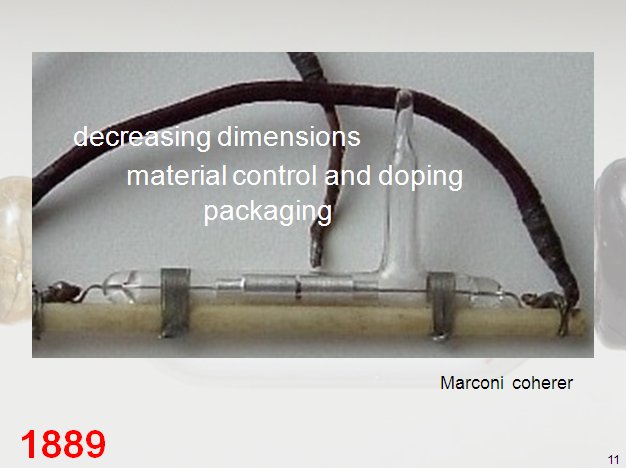
In the picture you see a coherer that
Marconi manufactured in 1898. To increase the sensitivity he had reduced the
distance between the electrodes to less than a millimeter. He also found that the
coherer worked better when a small fraction of hard-silver was added to the
nickel filings. Finally, the device was placed in a vacuum tube to prevent oxidation
of the filling. In it’s crude form this device already contained all the elements
which were going to keep us device engineers busy for the next century:
decreasing dimensions, material control and doping, and packaging!

In 1904 the British physicist John Ambrose Flemming was, as scientific
advisor to Marconi, studying the detection of electromagnetic waves using a new
device: the magnetic detector. This detector reproduced the sparks from the
transmitter as soft clicks in a headphone. Now Flemming was to a large extend
deaf, so he had a problem in hearing these soft clicks, frustrated by his handicap,
he started thinking about ways to make the signal visible, rather than audible. He
remembered some experiments he had been doing almost a decade before when
he was employed as a scientific advisor to Edison.

In these experiments he
investigated an effect that Edison himself had discovered in 1886. Trying to
reduce the blackening of the glass balloon of his light bulbs, Edison had placed a
metal plate in the balloon. Edison discovered that this plate conducted a current
when it was connected to a positive voltage, but that there was no current when
it was at a negative potential. Edison had no clue to the explanation of this
phenomenon and he also didn’t have a practical application for it, but he
patented it nevertheless just by habit.

Remembering his old experiments
Flemming dug up one of his old test lamps and in an improvised set-up
demonstrated for the first time the detection of radio waves with a vacuum valve.
It was an immediate success. The vacuum valve or diode quickly replaced the
coherer and all the other cumbersome detectors that had been developed in the
mean time.

Lee de Forest and Flemming couldn’t have differed more: Flemming was
the settled and renowned scientist, while de Forest basically was a penny less
entrepreneur. On one point however they had a common interest, during his PhD
on the reflection of electric waves, also de Forest became obsessed by the search
for a good and practical detector. In 1906, this quest left him, after several jobs
and unsuccessful ventures, almost bankrupt. Desperate, de Forest then
remembered how, several years before, his spark transmitter would affect the
flames of the gas-lighting. In an act of desperacy he placed two electrodes in the
flame of a Bunsen-burner, and low and behold it worked as a radio detector! De
Forest explained his flame detector from an unknown interaction of RF-signals on
ionized gasses. It was therefore only natural that his next step was a more
robust system in which the flame was replaced by a heated filament in a gas filled
tube. For de Forest his “Audion,” as he called his three terminal device, was
just a detector, and as such it was used for the next years. Then in 1912 de Forest
took up his experiments with his Audion again and he started to explore its
properties as an amplifying device. After much tinkering he developed a three
stage circuit that could amplify telephone signals and he sold the rights of his
Audion to AT&T. AT&T placed the development of the Audion in the hands of
H.D. Arnold. Arnold was a pupil of the famous physicist Robert Millikan
and as such was much better informed about the latest developments in electron-
theory than de Forest. Arnold immediately understood that the presence of gas in
the Audion seriously hampered the flow of electrons, and he quickly replaced it
by a vacuum. Within no time Arnold had improved the Audion so much, that it
became a useful amplifying device, the triode was born. In 1913 the first
oscillators using triodes were realized. At last there was an efficient way to
produce continuous waves that could replace the bulky and especially noisy
mechanical equipment that had to be used in the past.

The military must
have been ecstatic! With the First World-War starting in 1914, it was the ideal
device for wireless communication in a dirty trench fought war.
This pretty much summarizes the situation in 1917. Radio was something
exclusively for the post-offices and the military with the triode being an extremely
new and still not well understood device.

For Holland, which as you will recall was
neutral during the conflict, all these developments had happened almost
unnoticed.
It is therefore not surprising that our military friends studied the
radio in the German airplane with unusual interest. Understanding the potential
of it for modern warfare, and facing an uneasy post-war relation with Belgium,
they commissioned captain “de Blauw” to construct a number of radio sets. For
the necessary radio tubes captain “de Blauw” naturally turned to the largest light-
bulb manufacturer in Europe, our national pride: Philips. So after having reviewed
the status of radio and radio tubes in 1917, let’s now for a moment recall the
position of Philips in 1917.

Philips was founded by Gerard Philips in 1891. Gerard came from a family
of entrepreneurs. His father was a banker, but he also ran a tobacco trading
company, a coffee roasting company a cotton mill and he owned a gas factory!
Gerard’s interest was however more in technology. In 1883 he graduated from
the faculty of Mechanical Engineering in Delft and a few years later supervised the
installation of electrical light on the Dutch steamer “Prince Willem of Orange” in
Glasgow. During this trip to Scotland he came into contact with the famous
physicist Thomson. He stayed with Thomson for a year, and during that period
learned everything there was to learn about electricity. Back in Holland, Gerard
developed his own technology for making light-bulbs.

With financial aid from his
father he bought a small factory in the picturesque country village of
Eindhoven and in 1891 the private partnership “Philips & Co” is founded.

The first years are not easy for Philips. Fierce competition amongst light-bulb
manufacturers, forces Gerard to lower prices and increase production. You see,
high-volume and low-cost is in the very genes of Philips.

Facing fierce competition
and expansion of his factory, Gerard makes a clever move: being himself more an
engineer than a business man, he makes his younger brother Anton a co-director,
responsible for the business aspects of the company. Together they form a
golden pair in which Anton tries to sell more lamps than his brother can produce
and vice versa. Business thrives, and across the road of the old factory new
immense buildings are erected and Philips grows at an enormous pace. In 1900,
less than 10 years after its foundation, production reaches 3 million light bulbs a
year, making Philips one of the largest light-bulb manufacturers in the world!

By 1910 the number of employees has reached 2000. Philips is now the largest
private employer in Holland. Then, an unexpected event upsets the otherwise so
peaceful life of the two brothers. At General Electric, after years of intense
research, William Coolidge had achieved a breakthrough by developing a
method for the fabrication of ductile “pulled” tungsten filaments. Tungsten
filaments can burn at much higher temperatures than carbon filaments, and
therefore produce whiter and more efficient light.

This development takes the
engineers in Eindhoven completely by surprise and they are at their wits ends. To
save the business, Anton is forced to sail to the US in October 1911 to buy
the necessary licenses and equipment. After his return, the equipment is quickly
installed and through an immense effort operational in less than three months.
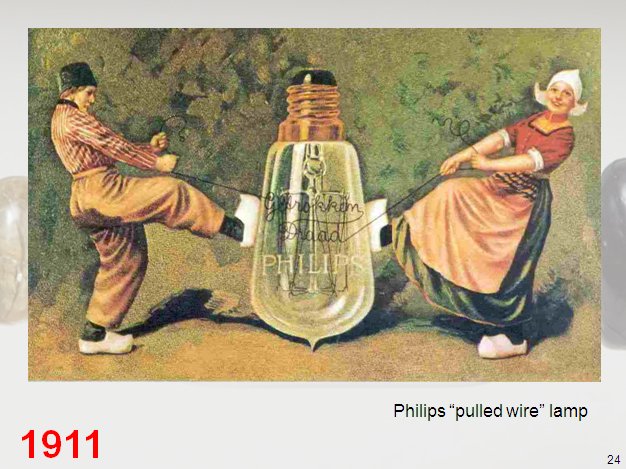
Again three months later the first lamps with a pulled wire are sold.
Within two years, it is again General Electric who for the second time takes Philips
by surprise when they introduce gas filled light-bulbs. In vacuum light-bulbs, the
maximum temperature of the filament, and consequently the efficiency, is limited
by the evaporation of the filament. It was well known that filling of the light-bulb
with an inert gas reduced the evaporation. However, gas filling the lamp would
also cool down the filament.

A breakthrough is achieved by Langmuir who,
after an extensive study of the conduction of heat through gasses, proposes to
use a thin double spiraled tungsten filament. This greatly reduces the heat-loss,
while still a high electrical resistance is maintained. Philips is again forced to buy a
license.
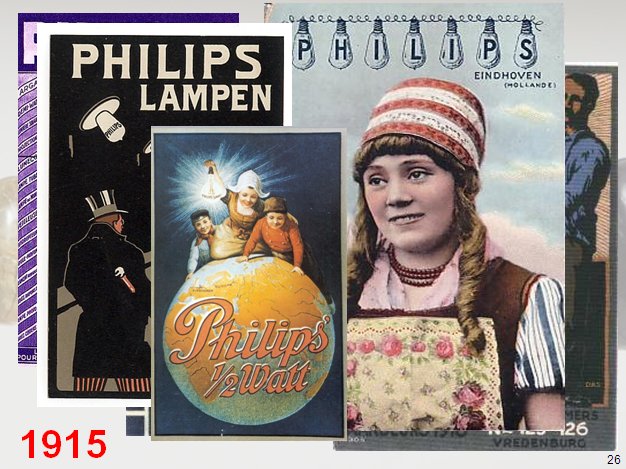
The technology is quickly introduced, and within no time the Philips
Argon filled lamps even prove superior over the lamps of G.E.
Gerard and Anton realize that the innovations from General Electric were the
result of fundamental physical research.

In the mean time, the Number of
employees of Philips has now grown to over 3500 and the company is about to
celebrate it’s 25th anniversary. The brothers recognize that for the future of the
company it is vital that Philips embarks on its own fundamental research
program.

So an advertisement for a scientist with a PhD in Physics is placed in
the newspapers. The scientist will be responsible for the setting up of a research
organization that will make Philips less dependent on patents from others and
that will generate new ideas for products.
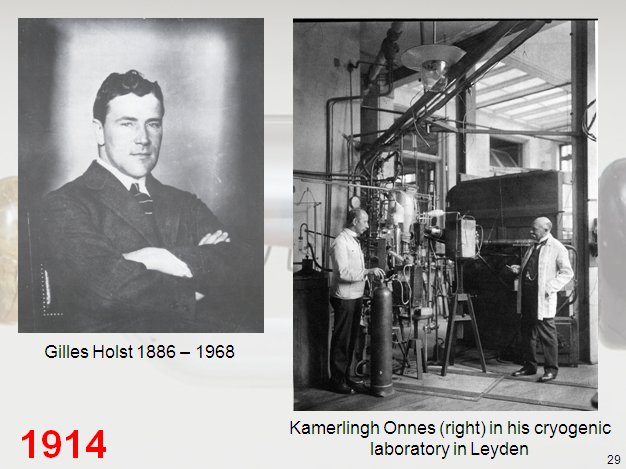
Among the applications that they receive is one from Gilles Holst. Holst did
his PhD under professor Kamerlingh Ohnes, who ran the low temperature lab in
Leiden. Ohnes was the first to liquefy Helium and to discover super conductivity in
mercury for which he received the Nobel Prize for Physics in 1913. It is
very refreshing how short and to the point Holst application letter was. After a
short C.V. he ends his letter with: ‘I would be pleased to learn from you when it
would be convenient to look you up so that we could discuss matters.’
After the
meeting, Holst is hired and he sets about organizing his lab. In 1914 Philips
Research or the “NatLab” as it is known in Eindhoven is founded.

Holst starts his new job by investigating the state-of-the-art in electrical lighting
and all of the aspects related to it. The results of his study are published in a
small book titled “Lichtbronnen en hare eigenschappen” (“electrical light sources
and their properties”). He concludes that it was already too late to carry out
fundamental research on incandescent light. The time was ripe to work on a new
source of electrical light: the discharge tube. Discharge tubes were still something
very new and fancy in 1914. Even the glow discharge itself was a phenomenon
which was still poorly understood at that time.

It is unfortunately beyond the
scope of this presentation to elaborate on the enormous role that Philips Research
would play in the understanding and application of gas-discharges. The
Tungsten Arc Lamp, the high pressure mercury and sodium lamps, the fluorescent
light tube, cathode sputtering, impurity gettering, the theory on discharges in gas
mixtures are but a few of the innovations originating from Philips Research in the
period between the two World-Wars. In the beginning however, Holst found it
difficult to hire competent researchers. The concept of an industrial lab was
something completely new for Holland in 1914. Holst was however determined in
positioning Philips Research as an internationally recognized research
organization.

In 1920 Holst is able to persuade the brilliant German physicist
Gustav Hertz to come to Eindhoven. Amongst many other things, Hertz
performed a beautiful experiment which established beyond all doubt that Bohr’s
electron states were linked to spectral lines. Later Hertz would receive the Nobel
Prize for his work which, to a large extend, was carried out at Philips.

In 1920 Paul Ehrenfest gives a series of lectures on some recent physics topics. His
example is followed by famous scientists such as James Frank, Otto Stern,
Albert Einstein, Hendrik Kramers and Arnold Sommerfeld.

In the following
decades, “het Natuurkundig Laboratorium” would grow into a Research
organization that could measure itself with the most renowned industrial research
labs in the world.

In the mean time captain “de Blauw,” still eager to get his hands on a supply
of radio tubes, made an appointment with Gillest Holst. As it happens, this is the
start of a remarkable chain of events. Holst politely receives him in Eindhoven and
listens to his story and request for help in the fabrication of radio tube samples.
Undoubtedly, Holst must have been fascinated by these new gadgets and the
physics that made them work. However, Holst also knew that Gerard Philips
considered radio and radio-tubes as a play thing for the military, and something
with little practical and commercial value! Holst finds it difficult to do something
that might upset his boss only three years after being appointed and although is
tempted, reluctantly turns down captain de Blauw’s request for help.

Disappointed, captain “ de Blauw” turns to one of the dozen or so other light-bulb
manufacturers in Holland: “de Metaaldraadlampenfabriek” in Utrecht. They
are quite willing to help him, and a few weeks later the first radio-tubes
manufactured in Holland are delivered to captain “de Blauw.”

In the development of radio into something as we know it today, radio
amateurs played an important role. The ending of the War, during which listening
to radio was forbidden, gave an enormous impulse to the popularity of radio
amateurism. But what to listen to? Most radio transmissions where in Morse code
originating from post offices, news agencies and of course the odd spy.
Transmission of speech, let alone music, was practically unheard of.

This was something that troubled the Dutch radio pioneer “Hanso Henricus Schotanus
à Steringa Idzerda,” a long and difficult to pronounce name, even to Dutch
standards. Idzerda, was an electrotechnical engineer and a keen radio amateur.
Already during the war Idzerda run a small wireless instruments and consultancy
agency from The Hague, mainly servicing the military. After the war, Idzerda
changed the name of his company to “Nederlandsche Radio-Industrie.” It is his
dream to build and sell radio receivers to ordinary civilians. Since there was
basically nothing to listen to, he intents to provide the buyers of his radio sets with
an interesting program consisting of news, music and radio plays transmitted
from his company in The Hague.
To realize his ambition, Idzerda needs a steady supply of radio tubes. So naturally
he first turns to the “Metaaldraadlampenfabriek” in Utrecht, who a year earlier
had provided captain “de Blauw” with radio tubes. They are however unable to
supply him the tubes since they have signed a “contract of secrecy” with the
Ministry of War. Idzerda now turns his hope to Philips.

One way or the other, he
is able to convince Gerard Philips himself of the economical significance of his
vision, because Gerard orders Holst and his staff to fabricate the tubes
according to Idzerda’s specifications. The tubes are advertised under the name
“IDEEZET-lamps,” and in an advertisement in “Radio Nieuws” of January 1919,
Idzerda proudly announces that already 1450 tubes have been sold.
Following instructions from Idzerda, Philips also manufactures several
transmission lamps.

In August that year the first transmissions take place
from Idzerda’s radio station, which transmits with less than 20 watts of RF power,
and is heard within a radius of 60km around “The Hague.” On the 5th of
November 1919, Idzerda places an advertisement in the news papers,
announcing a “Soirée-Musicale” for the following Thursday between eight and
eleven. It is a world-premiere, since it is the first radio broadcast which is
preceded by an announcement of the program in the news papers. The event is
internationally recognized as the birth of public radio broadcast. Idzerda’s radio
transmissions are very popular but fail to become an economical success, since
Idzerda entirely relies on voluntary contributions. The Dutch, although they
appreciate the music, are apparently not willing to pay for such a frivolity!
Fortunately, the English are more generous.

Idzerda’s radio station, which by
that time transmittes at a power level of 1kW, can be received in a large part of
the South of England, and is highly appreciated by the English. A fund raising
action in England organized by the popular magazine “The Wireless World,” raises
sufficient money. A few years later however, bankruptcy is inevitable.
In the following years, the fabrication of receiver tubes remains a relatively
insignificant activity compared to the fabrication of light-bulbs. This is however
not the case for X-ray tubes and transmission tubes. There, a stroke of luck places
Philips in ideal position.

In the early days of 1920, Gerard Holst visites one of
the glass-blowing factories where light-bulbs are being fabricated. He notices that
some of the glass-blowers have more difficulty in removing the light-bulb from
their blow-pipe than others. He finds this intriguing, and decides to investigate the
cause. He discovers that when the blow-pipes are made from a particular
chromium-iron alloy, they have an almost perfect adhesion and thermal match to
the glass. The story goes that Holst after founding the cause, immediately
rushed to the patent department and got the discovery patented. The patent
indeed proved of immense value to Philips.
Already during the war, Philips had repaired and fabricated on a small scale X-ray
tubes for hospitals which were not able to get spare parts. After the war this
activity was under fierce competition, especially from Germany.

The perfect
chromium-iron to glass seal was just the thing Philips needed to give them a
competitive edge. By making a part of the tubes from metal, it was possible to
strongly reduce stray radiation, and to effectively cool them. These tubes became
known as the METALLIX tube, and they formed the start of what is today Philips
Medical Systems.

Begin thirties the Medical System Division had grown to such
an extent that they had even penetrated the walls of the forbidden city in
China! Finally in 1923 the idea of public radio broadcasts really sets of, and the demand
for radio tubes explodes. Tube manufacturers are hardly able to supply the
demand and Philips quickly changes gears. After the fabrication of light-bulbs was
moved to a location just outside the center of Eindhoven, the huge plant on “de
Emmasingel” became available for the production of radio tubes. Whereas in
1921 only 320 radio tubes were fabricated in total, in 1923 the production had
increased to 1000 tubes a day!

In 1922 Gilest Holst hires the Dutch Scientist “Balthasar van der Pol” to head
the research and development of radio tubes. Van der Pol who had worked
under Thomson and Fleming in England was a brilliant scientist who already in
1917 in “Wireless World” had featured in an article “Personalities of the Wireless
World.” Van der Pol’s first job was to work on oxide coated filaments.

So far just
normal tungsten filaments had been used in radio tubes. To get sufficient
electron emission, these filaments had to be heated white hot, so that these tubes
were cold “hel branders” or “bright burners.” In fact the radios in those days gave
as much light as sound. To save batteries and tubes, van der Pol and his staff
developed barium and thorium coated filaments. The low work function of these
materials strongly increases the electron emission of the filaments, so that they
could burn at lower temperatures.

Philips successfully introduced these tubes
in 1924 under the brand name “Miniwatt.” At that moment already 9 out of the
16 researchers at Philips were working on radio tubes.

Sixty years later, researchers at Stanford introduced a very similar trick to
boost the performance of bipolar transistors. This time it is the bandgap of the
base which is decreased by the incorporation of a small amount of heterogeneous
material: Germanium. The result is the same: a higher current density, which in
this case is used to obtain higher switching speeds.
In 1924 Bernard Tellegen joins the radio tube research group of van der Pol. He is
then 24 years of age and has only just graduated. He was put on a very practical
problem. Due to new safety regulations, the anode voltage in radio receivers was
limited to less than 250V. At these low voltages it was difficult to generate enough
output power for a loud speaker with a simple triode.

The triode had namely
two serious drawbacks. First of all it didn’t behave like a current source. In other
words, the anode current not only increased with increasing grid voltage, but also
with increasing anode voltage. In bipolar transistor terms we would say: “it had a
low Early voltage.” This seriously limited the maximum amplification and the
output power of the tube. At the same time there was a strong capacitive
coupling between the anode and the grid. This Miller capacitance limited the high
frequency operation.

In 1915, a remedy to these drawbacks was found by an
old acquaintance of us: Walter Schottky. By inserting a screen grid in between the
control grid and the anode, which was held at a constant high potential, the
anode potential is effectively screened from control grid. In its hybrid form this
arrangement is of course still widely used, and is known as a cascode. The tetrode
as is was called, represented an enormous improvement, but in its turn also had a
drawback. Electrons accelerated by the high potential on the screen grid bombard
the anode and generate secondary electrons.

Unfortunately, in operating
conditions where the anode voltage is low compared to the screen grid, these
secondary electrons are accelerated to the screen grid, causing a current flow in
the opposite direction. The result is a kink in the anode current characteristics,
not unlike the kink in SOI MOSFET’s. The problem especially occurred in
output stages where the output voltage would swing between supply voltage and
almost zero. Tellegen studied the problem, and came up with a very simply
solution.

He simply inserted a third grid between the screen grid and the
anode. This brake- or suppressor grid was connected to a low potential e.g. the
cathode. The suppressor grid simply pushed the secondary electrons back to the
anode and all at once all the disadvantages of the tetrode had disappeared. The
pentode was a near ideal amplifying device with very high amplification and
capable of delivering high output powers at relatively low voltages.
Tellegen and Holst immediately applied for a patent on the 14th of December
1926.

It turned out to be perhaps the most valuable patent of Philips ever.
Philips sat on the patent like a tiger protecting its young. In 1927, Philips becomes
the largest radio tube manufacturer in Europe. Because of the pentode patent the
European market was not interesting for the Americans at all. As a result the
European and American tube markets developed almost independently, with
different type numbers, envelopes, sockets etc. The protectionism of Philips was
so strong that they would even order confiscation of radio tubes that radio shop
owners directly imported from the U.S.! In 1932, little more than 10 years after
the first samples were made at the research lab, Philips produced it’s 100
millionth’s radio tube.

Tellegen remained extremely productive throughout his long career with
Philips. He invented the Gyrator and developed “The Tellegen Theorem,” one of
the most powerful theorems in network theory. In 1973 he received as first non
American the IEEE Edison Medal Award. Up to a few years before his death in
1990, he continued to visit the library at Philips Research and after which he
would enjoy a sober lunch in the canteen.

The mathematical treatment of multigrid tubes like Tellegens pentode was
extremely complicated. That is why Jonkers at Philips Research resorted to a
completely new approach: device simulation! Instead of using finite element
calculations as we do today, he used a typical solution from the time of slide rules:
a mechanical equivalent. The simulator consisted of a rubber sheet that was
suspended in a frame. sticks, representing electrodes, were placed underneath
the sheet of rubber that could push the rubber sheet either upward – in case of a
negative potential - or pull it downward – in case of a positive potential.

At one
side of the rubber sheet, at the position of the imaginary cathode, an array of
tubes launched small metal bullets representing the electrons.
A camera and
a stroboscope recorded the trajectory and the velocity of the electrons. Simple,
reasonably accurate and very fast!
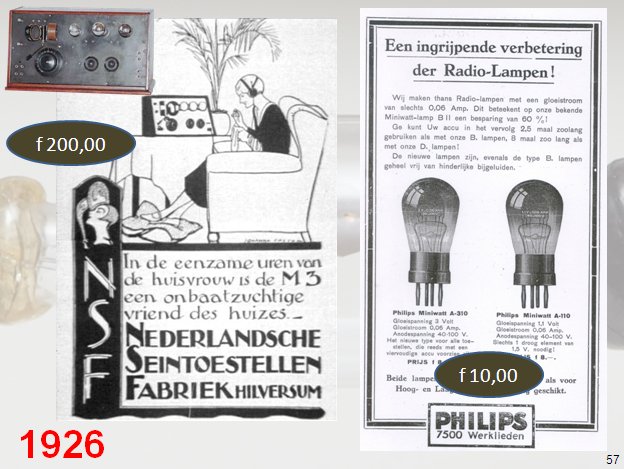
In the mean time the popularity of radio increased explosively, and it had not
remained unnoticed by Anton Philips that, whereas the price of a radio tube
on average was 10 guilders, the price of a complete radio was about 200
guilders. So obviously making radio sets was a very profitable business. This
combined with the fact that Philips now had their hands on a superior radio tube,
the pentode, made them feel confident enough to start thinking about producing
radio’s themselves. For Philips in 1926 this was something of a revolution. So far
Philips had been a component manufacturer. A radio was a system, and
manufacturing a system would require a completely different approach! From the
onset it was clear that the receiver had to be suitable for mass-production, it
should be reliable, easy to use, of high quality and reasonably priced. Visits were
paid to RCA in the US to study mass production. A thorough study was made on
how something so complex as a radio could be made on a large scale with a high
accuracy and yield by unskilled hands.
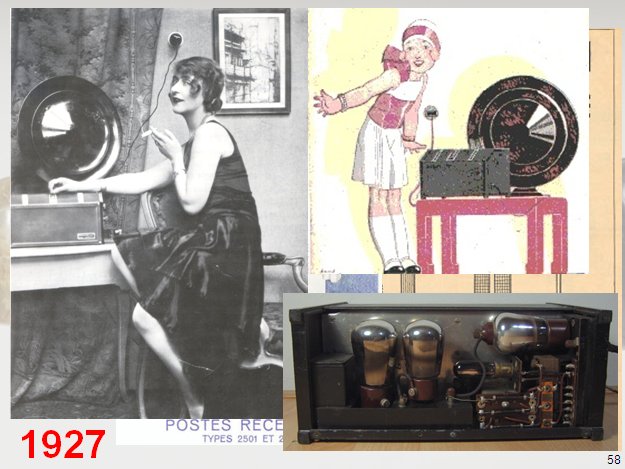
The result was the 2501, in Holland
nick-named “the loaf of bread.” Because of the high gain of the pentode, only
three radio tubes were needed compared to four in radios from competitors.

It was an enormous success. In 1927, 6000 receivers were built, in 1930 the
production had already increased to half a million radio’s a year.
Well, as they say; “The rest is History.” Philips grew and grew. In the beginning of
the fifties the production of radio tubes reached 200 million pieces a year. By that
time factories in France, England and Germany have been bought or built, which
produce radio tubes under local brand names such as Mullard or Valvo.
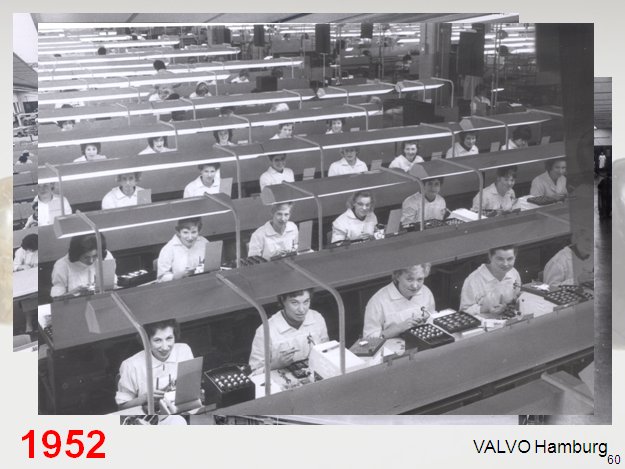
In
the factory of VALVO in Hamburg alone, 5000 people, mainly women, work on
the assembly of radio tubes.
With Philips, the NatLab grew and in the fifties it moved to the beautiful location
were we are now.

Well Ladies and Gentlemen, I see some impatient and I know that many of
you have a Christmas celebration after this presentation, so let’s see if we can end
with some conclusions:
Always listen to the Boss?
The questionmark needs some explaining. In Holland we have the popular
tradition never to listen the boss whatsoever! However, in retrospect it was
indeed a wise decision of Holst to listen to the wishes of his Boss Gerard Philips,
when he turned down the request for help from the military. Suppose for a
moment that Holst had decided to help them, in that case Philips would have been
tied down by a secrecy contract and most likely the “metaaldraadlampfabriek” in
Utrecht would have manufactured Idzera’s radio tubes. Possibly in that case they
would have grown to become a multinational, buying up Philips as they grew, and
as a consequence we would be having this colloquium in one of the suburbs of
Utrecht instead of in Waalre. Of course Gerard Philips was not just any boss. In
little more than 25 years he had built a multinational that had transformed a
complete region of Holland. On top of that he was fully up to date with every
technical and scientific aspect of his business. Obviously it depends on who
actually the boss is. Unfortunately bosses like Gerard Philips are rare these days,
so perhaps it is best to stick to our Dutch tradition!
Philips Research has been invaluable for the company!
This was only a very brief and short overview of the early years of Philips, I
nevertheless think that you will agree with me that Philips indeed owes a lot to its
research organization! The research on radio tubes directly led to the
development of the consumer product division, while the work on X-ray tubes led
to Philips Medical Systems. Together with light the three pillars that Philips is
again resting on today.
Pay attention to details!
Edison saw a current flowing in one direction and not in the other. He didn’t
understand it and could have ignored it as a measurement error. Instead he
patented it and is still remembered for it. For De Forest it was the flickering of his
gas light every time when he switched his transmitter on that set him on the trail
of the triode. Holst observed that some glass blowers had difficulty in removing a
glass balloon from their blow pipes. He investigated this seemingly insignificant
detail and discovered the merits of the chromium-iron alloy that eventually led to
what is now Philips Medical Systems. Tellegen was annoyed by a small kink in the
output characteristic of the tetrode and discovered the pentode. So details
matter! Do not ignore them! Details make the difference between a great
publication and a Nobel Prize.
l’Histoire se répète
Why bother with all this history stuff? What is the point in it? The people are all
dead and technologies are obsolete. Well, I have tried to show you that in many
respects the problems that faced the engineers and scientists in the early tube
period were quite similar to the problems that we know from transistors and
integrated circuits. More important, the same applies to the solutions that were
found. Material and vacuum purity, gettering (a word even directly taken over
from the tube period), the drive towards smaller dimensions, the need for higher
current densities and the use of heterogeneous materials to achieve this, the
importance of packaging and packaging parasitics. The list is endless. The
transistor was to a large extend the work of a new and fresh group of engineers
and consequently many things had to be “re-discovered.” I strongly suspect that
in the field of what we call “nano-electronics,” the same is happening again today!
For me personally, I find the study of the history of our profession inspiring and
fun. Finally, and being here in the catholic south I can say this without hesitation,
having fun in what we do is in the end the most important thing.
| to top of page | back to homepage |